每一個可以努力的日子,都是一份厚禮。
深入理解 AngularJS 的 Scope
JavaScript 的原型繼承就是奇葩。
之前在 V2EX 上看到討論說,不會 OOP 的 JavaScript 的程序員就是野生程序員。看來我是屬於野生的。
一、遇到的問題
問題發生在使用 AngularJS 嵌套 Controller 的時候。因為每個 Controller 都有它對應的 Scope(相當於作用域、控制範圍),所以 Controller 的嵌套,也就意味着 Scope 的嵌套。這個時候如果兩個 Scope 內都有同名的 Model 會發生什麼呢?從子 Scope 怎樣更新父 Scope 里的 Model 呢?
這個問題很典型,比方說當前頁面是一個產品列表,那麼就需要定義一個 ProductListController
function ProductListController($scope, $http) { $http.get('/api/products.json') .success(function(data){ $scope.productList = data; }); $scope.selectedProduct = {}; } |
你大概看到了在 Scope 里還定義了一個 selectedProduct 的 Model,表示選中了某一個產品。這時會獲取該產品詳情,而頁面通過 AngularJS 中的 $routeProvider 自動更新,拉取新的詳情頁模板,模板中有一個 ProductDetailController
function ProductDetailController($scope, $http, $routeParams) { $http.get('/api/products/'+$routeParams.productId+'.json') .success(function(data){ $scope.selectedProduct = data; }); } |
有趣的事情發生了,在這裡也有一個 selectedProduct ,它會怎樣影響 ProductListController 中的 selectedProduct 呢?
答案是沒有影響。在 AnuglarJS 里子 Scope 確實會繼承父 Scope 中的對象,但當你試下對基本數據類型(string, number, boolean)的 雙向數據綁定 時,就會發現一些奇怪的行為,繼承並不像你想象的那樣工作。子 Scope 的屬性隱藏(覆蓋)了父 Scope 中的同名屬性,對子 Scope 屬性(表單元素)的更改並不更新父 Scope 屬性的值。這個行為實際上不是 AngularJS 特有的,JavaScript 本身的原型鏈就是這樣工作的。開發者通常都沒有意識到 ng-repeat, ng-switch, ng-view 和 ng-include 統統都創建了他們新的子 scopes,所以在用到這些 directive 時也經常出問題。
二、解決的辦法
解決的辦法就是不使用基本數據類型,而在 Model 里永遠多加一個點.
使用 <input type="text" ng-model="someObj.prop1"> 來替代 <input type="text" ng-model="prop1"> |
是不是很坑爹?下面這個例子很明確地表達了我所想表達的奇葩現象
app.controller('ParentController',function($scope){
$scope.parentPrimitive = "some primitive"
$scope.parentObj = {};
$scope.parentObj.parentProperty = "some value";
});
app.controller('ChildController',function($scope){
$scope.parentPrimitive = "this will NOT modify the parent"
$scope.parentObj.parentProperty = "this WILL modify the parent";
}); |
查看 在線演示 DEMO
但是我真的確實十分很非常需要使用 string number 等原始數據類型怎麼辦呢?2 個方法——
- 在子 Scope 中使用
$parent.parentPrimitive。 這將阻止子 Scope 創建它自己的屬性。 - 在父 Scope 中定義一個函數,讓子 Scope 調用,傳遞原始數據類型的參數給父親,從而更新父 Scope 中的屬性。(並不總是可行)
三、JavaScript 的原型鏈繼承
吐槽完畢,我們來深入了解一下 JavaScript 的原型鏈。這很重要,特別是當你從服務器端開發轉到前端,你應該會很熟悉經典的 Class 類繼承,我們來回顧一下。
假設父類 parentScope 有如下成員屬性 aString, aNumber, anArray, anObject, 以及 aFunction。子類 childScope 原型繼承父類 parentScope,於是我們有:
如果子 Scope 嘗試去訪問 parentScope 中定義的屬性,JavaScript 會先在子 Scope 中查找,如果沒有該屬性,則找它繼承的 scope 去獲取屬性,如果繼承的原型對象 parentScope 中都沒有該屬性,那麼繼續在它的原型中尋找,從原型鏈一直往上直到到達 rootScope。所以,下面的表達式結果都是 ture:
childScope.aString === 'parent string' childScope.anArray[1] === 20 childScope.anObject.property1 === 'parent prop1' childScope.aFunction() === 'parent output' |
假設我們執行下面的語句
childScope.aString = 'child string' |
原型鏈並沒有被查詢,反而是在 childScope 中增加了一個新屬性 aString。這個新屬性隱藏(覆蓋)了 parentScope 中的同名屬性。在下面我們討論 ng-repeat 和 ng-include 時這個概念很重要。
假設我們執行這個操作:
childScope.anArray[1] = '22' childScope.anObject.property1 = 'child prop1' |
原型鏈被查詢了,因為對象 anArray 和 anObject 在 childScope 中沒有找到。它們在 parentScope 中被找到了,並且值被更新。childScope 中沒有增加新的屬性,也沒有任何新的對象被創建。(註:在 JavaScript 中,array 和 function 都是對象)
假設我們執行這個操作:
childScope.anArray = [100, 555] childScope.anObject = { name: 'Mark', country: 'USA' } |
原型鏈沒有被查詢,並且子 Scope 新加入了兩個新的對象屬性,它們隱藏(覆蓋)了 parentScope 中的同名對象屬性。
應該可以總結
- 如果讀取 childScope.propertyX,並且 childScope 有屬性 propertyX,那麼原型鏈沒有被查詢。
- 如果設置 childScope.propertyX,原型鏈不會被查詢。
最後一種情況,
delete childScope.anArray childScope.anArray[1] === 22 // true |
我們從 childScope 刪除了屬性,則當我們再次訪問該屬性時,原型鏈會被查詢。刪除對象的屬性會讓來自原型鏈中的屬性浮現出來。
四、AngularJS 的 Scope 繼承
- 創建新的 Scope,並且原型繼承:ng-repeat, ng-include, ng-switch, ng-view, ng-controller, directive with
scope: true, directive withtransclude: true - 創建新的 Scope,但不繼承:directive with
scope: { ... }。它會創建一個獨立 Scope。
註:默認情況下 directive 不創建新 Scope,即默認參數是 scope: false。
ng-include
假設在我們的 controller 中,
$scope.myPrimitive = 50; $scope.myObject = {aNumber: 11}; |
HTML 為:
<script type="text/ng-template" id="/tpl1.html"> <input ng-model="myPrimitive"> </script> <div ng-include src="'/tpl1.html'"></div> <script type="text/ng-template" id="/tpl2.html"> <input ng-model="myObject.aNumber"> </script> <div ng-include src="'/tpl2.html'"></div> |
每一個 ng-include 會生成一個子 Scope,每個子 Scope 都繼承父 Scope。
輸入(比如”77″)到第一個 input 文本框,則子 Scope 將獲得一個新的 myPrimitive 屬性,覆蓋掉父 Scope 的同名屬性。這可能和你預想的不一樣。
輸入(比如”99″)到第二個 input 文本框,並不會在子 Scope 創建新的屬性,因為 tpl2.html 將 model 綁定到了一個對象屬性(an object property),原型繼承在這時發揮了作用,ngModel 尋找對象 myObject 並且在它的父 Scope 中找到了。
如果我們不想把 model 從 number 基礎類型改為對象,我們可以用 $parent 改寫第一個模板:
<input ng-model="$parent.myPrimitive"> |
輸入(比如”22″)到這個文本框也不會創建新屬性了。model 被綁定到了父 scope 的屬性上(因為 $parent 是子 Scope 指向它的父 Scope 的一個屬性)。
對於所有的 scope (原型繼承的或者非繼承的),Angular 總是會通過 Scope 的 $parent, $$childHead 和 $$childTail 屬性記錄父-子關係(也就是繼承關係),圖中為簡化而未畫出這些屬性。
在沒有表單元素的情況下,另一種方法是在父 Scope 中定義一個函數來修改基本數據類型。因為有原型繼承,子 Scope 確保能夠調用這個函數。例如,
// 父 Scope 中 $scope.setMyPrimitive = function(value) { $scope.myPrimitive = value; } |
查看 DEMO。參考 StackOverflow。
ng-switch
ng-switch 的原型繼承和 ng-include 一樣。所以如果你需要對基本類型數據進行雙向綁定,使用 $parent,或者將其改為 object 對象並綁定到對象的屬性,防止子 Scope 覆蓋父 Scope 的屬性。
參考 AngularJS, bind scope of a switch-case?
ng-repeat
ng-repeat 有一點不一樣。假設在我們的 controller 里:
$scope.myArrayOfPrimitives = [ 11, 22 ]; $scope.myArrayOfObjects = [{num: 101}, {num: 202}] |
還有 HTML:
<ul> <li ng-repeat="num in myArrayOfPrimitives"> <input ng-model="num"> </li> <ul> <ul> <li ng-repeat="obj in myArrayOfObjects"> <input ng-model="obj.num"> </li> <ul> |
對於每一個 Item,ng-repeat 創建新的 Scope,每一個 Scope 都繼承父 Scope,但同時 item 的值也被賦給了新 Scope 的新屬性(新屬性的名字為循環的變量名)。Angular ng-repeat 的源碼實際上是這樣的:
childScope = scope.$new(); // 子 scope 原型繼承父 scope ... childScope[valueIdent] = value; // 創建新的 childScope 屬性 |
如果 item 是一個基礎數據類型(就像 myArrayOfPrimitives),本質上它的值被複制了一份賦給了新的子 scope 屬性。改變這個子 scope 屬性值(比如用 ng-model,即 num)不會改變父 scope 引用的 array。所以上面第一個 ng-repeat 里每一個子 scope 獲得的 num 屬性獨立於 myArrayOfPrimitives 數組:
這樣的 ng-repeat 和你預想中的不一樣。在 Angular 1.0.2 及更早的版本,向文本框中輸入會改變灰色格子的值,它們只在子 Scope 中可見。Angular 1.0.3+ 以後,輸入文本不會再有任何作用了。(參考 StackOverflow 上的解釋)我們希望的是輸入能改變 myArrayOfPrimitives 數組,而不是子 Scope 里的屬性。為此我們必須將 model 改為一個關於對象的數組(array of objects)。
所以如果 item 是一個對象,則對於原對象的一個引用(而非拷貝)被賦給了新的子 Scope 屬性。改變子 Scope 屬性的值(使用 ng-model,即 obj.num)也就改變了父 Scope 所引用的對象。所以上面第二個 ng-repeat 可表示為:
這才是我們想要的。輸入到文本框即會改變灰色格子的值,該值在父 Scope 和子 Scope 均可見。
參考 Difficulty with ng-model, ng-repeat, and inputs 以及 ng-repeat and databinding。
ng-controller
使用 ng-controller 進行嵌套,結果和 ng-include 和 ng-switch 一樣是正常的原型繼承。所以做法也一樣不再贅述。然而“兩個 controller 使用 $scope 繼承來共享信息被認為是不好的做法”(來自 這裡),應該使用 service 在 controller 間共享數據。
如果你確實要通過繼承來共享數據,那麼也沒什麼特殊要做的,子 Scope 可以直接訪問所有父 Scope 的屬性。參考 Controller load order differs when loading or navigating。
directives
這個要分情況來討論。
- 默認
scope: false– directive 不會創建新的 Scope,所以沒有原型繼承。這看上去很簡單,但也很危險,因為你會以為 directive 在 Scope 中創建了一個新的屬性,而實際上它只是用到了一個已存在的屬性。這對編寫可復用的模塊和組件來說並不好。 scope: true– 這時 directive 會創建一個新的子 scope 並繼承父 scope。如果在同一個 DOM 節點上有多個 directive 都要創建新 scope,則只有一個新 Scope 會創建。因為有正常的原型繼承,所以和 ng-include, ng-switch 一樣要注意基礎類型數據的雙向綁定,子 Scope 屬性會覆蓋父 Scope 同名屬性。scope: { ... }– 這時 directive 創建一個獨立的 scope,沒有原型繼承。這在編寫可復用的模塊和組件時是比較好的選擇,因為 directive 不會不小心讀寫父 scope。然而,有時候這類 directives 又經常需要訪問父 scope 的屬性。對象散列(object hash)被用來建立這個獨立 Scope 與父 Scope 間的雙向綁定(使用 ‘=’)或單向綁定(使用 ‘@’)。還有一個 ‘&’ 用來綁定父 Scope 的表達式。這些統統從父 Scope 派生創建出本地的 Scope 屬性。注意,HTML 屬性被用來建立綁定,你無法在對象散列中引用父 Scope 的屬性名,你必須使用一個 HTML 屬性。例如,<div my-directive>和scope: { localProp: '@parentProp' }是無法綁定父屬性 parentProp 到獨立 scope的,你必須這樣指定:<div my-directive the-Parent-Prop=parentProp>以及scope: { localProp: '@theParentProp' }。獨立的 scope 中__proto__引用了一個 Scope 對象(下圖中的桔黃色 Object),獨立 scope 的 $parent 指向父 scope,所以儘管它是獨立的而且沒有從父 Scope 原型繼承,它仍然是一個子 scope。
下面的圖中,我們有<my-directive interpolated="{{parentProp1}}" twowayBinding="parentProp2">和scope: { interpolatedProp: '@interpolated', twowayBindingProp: '=twowayBinding' }。
同時,假設 directive 在它的 link 函數里做了scope.someIsolateProp = "I'm isolated"
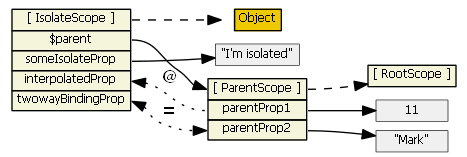
注意:在 link 函數中使用attrs.$observe('attr_name', function(value) { ... }來獲取獨立 Scope 用 ‘@’ 符號替換的屬性值。例如,在 link 函數中有attrs.$observe('interpolated', function(value) { ... }值將被設為 11. (scope.interpolatedProp在 link 函數中是 undefined,相反scope.twowayBindingProp在 link 函數中定義了,因為用了 ‘=’ 符號)
更多參考 http://onehungrymind.com/angularjs-sticky-notes-pt-2-isolated-scope/transclude: true– 這時 directive 創建了一個新的 “transcluded” 子 scope,同時繼承父 scope。所以如果模板片段中的內容(例如那些將要替代 ng-transclude 的內容)要求對父 Scope 的基本類型數據進行雙向綁定,使用 $parent,或者將 model 一個對象的屬性,防止子 Scope 屬性覆蓋父 Scope 屬性。
transcluded 和獨立 scope (如果有)是兄弟關係,每個 Scope 的 $parent 指向同一個父 Scope。當模板中的 scope 和獨立 Scope 同時存在,獨立 Scope 屬性 $$nextSibling 將會指向模板中的 Scope。
更多關於 transcluded scope 的信息,參考 AngularJS two way binding not working in directive with transcluded scope。
在下圖中,假設 directive 和上個圖一樣,只是多了transclude: true

查看 在線 DEMO,例子里有一個 showScope() 函數可以用來檢查獨立 Scope 和它關聯的 transcluded scope。
總結
一共有四種 Scope:
- 普通進行原型繼承的 Scope —— ng-include, ng-switch, ng-controller, directive with
scope: true - 普通原型繼承的 Scope 但拷貝賦值 —— ng-repeat。 每個 ng-repeat 的循環都創建新的子 Scope,並且子 Scope 總是獲得新的屬性。
- 獨立的 isolate scope —— directive with
scope: {...}。它不是原型繼承,但 ‘=’, ‘@’ 和 ‘&’ 提供了訪問父 Scope 屬性的機制。 - transcluded scope —— directive with
transclude: true。它也遵循原型繼承,但它同時是任何 isolate scope 的兄弟。
對於所有的 Scope,Angular 總是會通過 Scope 的 $parent, $$childHead 和 $$childTail 屬性記錄父-子關係。
| 這篇文章由lovelucy於2013-07-28 18:49發表在前端開發。你可以訂閱RSS 2.0 也可以發表評論或引用到你的網站。除特殊說明外文章均為本人原創,並遵從署名-非商業性使用-相同方式共享創作協議,轉載或使用請註明作者和來源,尊重知識分享。 |
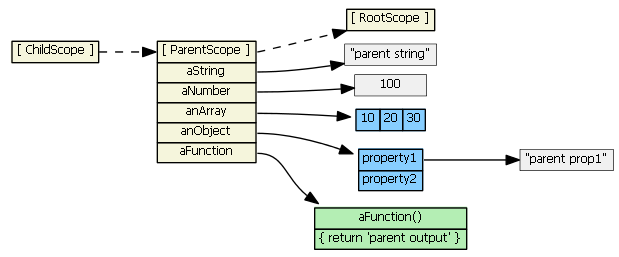
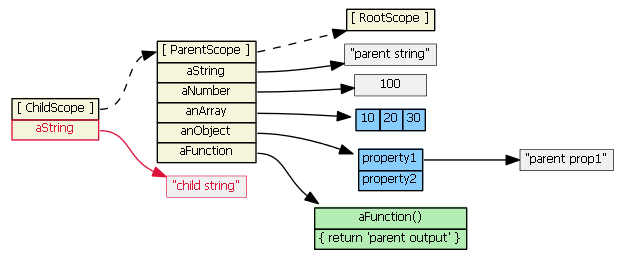

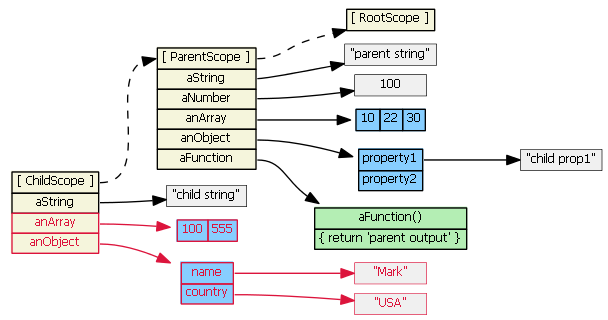
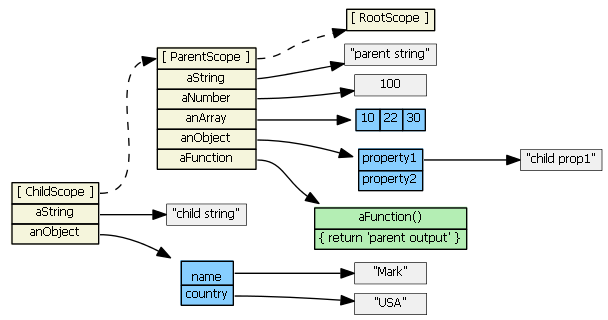




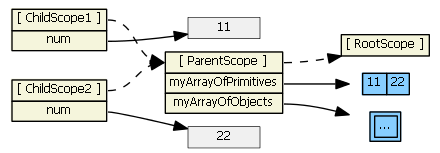

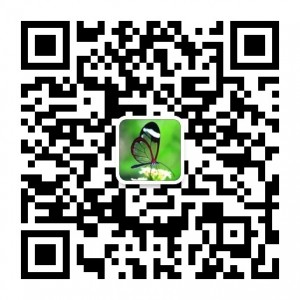
😛 寫的很棒!
😛 雖然是好的東西,可我看不懂
!! 寫得太棒了,解開我很多的疑惑
這是angular在github項目上的wiki原文翻譯的……
一、正確用法
http://jsfiddle.net/xxNxj/5/
這個寫的非常深入,值得好好研究!
見到代碼就頭痛
不是 這個專業的 太深的東西看不懂! 不過只能看個大概